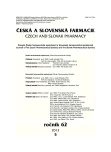Evaluation of liberation of caffeine from dermal semisolids drugs
Authors:
Alexandra Kodadová; Zuzana Vitková; Petra Herdová
Authors‘ workplace:
Farmaceutická fakulta, Katedra galenickej farmácie
; Univerzita Komenského v Bratislave
Published in:
Čes. slov. Farm., 2013; 62, 220-222
Category:
Original Articles
Overview
The paper deals with formulation of caffeine into dermal semisolid dosage forms - hydrogels. Caffeine was chosen as a model drug because its properties can be successfully used just in hydrogels. Protective and tranquilization effects can be used in the preparations for sunbathing, and its lipolytic and regenerative effect can be used for the treatment of androgenic alopecia or cellular bioprotection. The aim of the study was to investigate the influence of different concentrations of chitosan and caffeine on the liberation of gels. Besides, stability of the prepared samples was evaluated by means of the evaluation of their rheological parameters. Based on the obtained results, there was determined the optimal drug concentration – caffeine 0.2% (w/w) and also the gel forming substance – chitosan 2.3% (w/w).
Keywords:
caffeine • hydrogels • chitosan • liberation • rheological parameters
Sources
1. Velasco M. V. R., Tano C. T. N., Machado-Santelli G. M., Consiglieri V. O., Kaneko T. M., Baby A. R. Effects of caffeine and siloxanetriol alginate caffeine, as anticellulite agents, on fatty tissue: histological evaluation. JCD. 2008; 7, 23–29.
2. Bansal M., Manchanda K., Pandey S. S. Role of Caffeine in the Management of Androgenetic Alopecia. Int J Trichology 2012; 4, 185–186.
3. Herdová P., Vitková Z. Štúdium liberácie liečiv z chitosanových hydrogélov. Derma 2010; 10, 20.
Labels
Pharmacy Clinical pharmacologyArticle was published in
Czech and Slovak Pharmacy

2013 Issue 5
Most read in this issue
-
Standard prescriptions for extemporaneously produced medicinal preparations in pharmacies
VI. Collection Neues Rezeptur-Formularium - A combination of grapefruit seed extract and concentrated cranberry juice as a potential antimicrobial preservative for the improvement of microbiological stability of hypromellose gel
- Influence of temperature and concentration of a surfactant on pharmaceutical availability
- Evaluation of liberation of caffeine from dermal semisolids drugs
